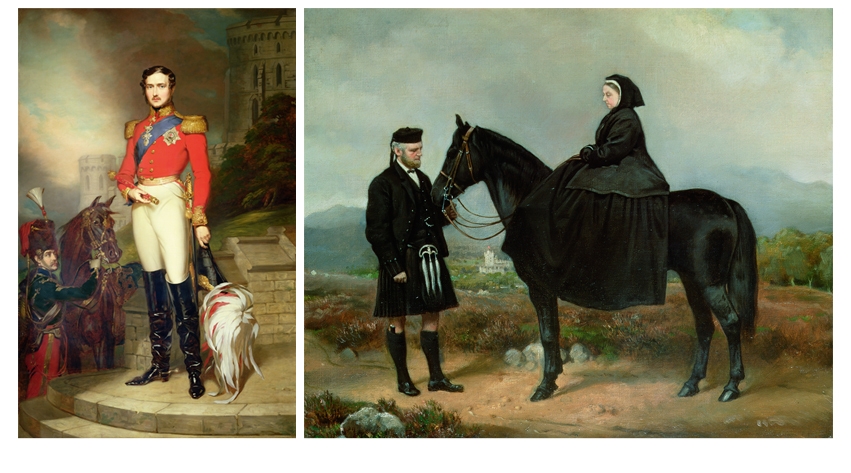The history of the royal family is punctuated by dramatic, premature deaths which plunge the monarchy into crisis. The most disastrous of these — historically more significant by far than the death of Princess Diana — was the death of Prince Albert in 1861. By the time he died, aged 42, this minor German prince, the second son of the obscure and dissipated Duke of Coburg, had taken over the entire public work of the monarchy. After 21 years of marriage, his wife Victoria had become deskilled and emotionally dependent upon him. His death left the monarchy in tatters and condemned Queen Victoria to a lifetime of black dresses. Helen Rappaport, who is best known as a writer about the Romanovs, has chosen an excellent subject.
The official cause of Albert’s death was given as typhoid fever, but this has been questioned for some time. Albert suffered from recurrent gastric attacks which worsened markedly during the last years of his life. Interestingly, Rappaport speculates that he was a victim of Crohn’s disease; we shall never really know what was wrong, as there was no autopsy. Behind the image of the happy, bourgeois family which Albert carefully crafted, there lay painful tensions. Victoria, first and always a queen, was conflicted about sharing her power with Albert. Exhausted by Victoria’s emotional neediness, Albert was depressed and lonely. A workaholic with no real friends, he was unpopular with his adopted people, for whom he wore himself out.
Albert was strangely resigned to death. When he fell ill, he seemed to accept too readily that he would never recover. At Windsor, wearing his scarlet padded dressing gown, he paced feverishly from room to room while his anxious wife trailed after him. He was nursed by his daughter Alice, and the doctors attempted to conceal the worst from the near-hysterical queen.
Rappaport uses new sources to give a vivid account of Albert’s death.
Victoria collapsed with grief. She shut herself away, seeing no one but her ladies-in-waiting and howling down the corridors of her palaces. Albert’s room was preserved as a shrine, and Victoria threw herself into the architecture of death, creating the mausoleum at Frogmore as well as the Albert Memorial. Rappaport sees her as clinically depressed. Rather than comfort her sad children, she punished and bullied them. Especially vindictive was her treatment of her son Bertie, Prince of Wales, whom she blamed for Albert’s death.
Grief became a way of life. Victoria was annoyed when people told her that she looked better: she dreaded doing the work of monarch on her own. Utterly self-absorbed in her mourning, Victoria was unapproachable and terrifying. She claimed to labour long hours on her red boxes but, as Rappaport shows, her private secretaries knew very well that she worked far less than she pretended. Her pliant doctor Jenner pandered to her neuroses, and whenever she needed an excuse for shirking an engagement, he provided a sick note. He judged her ‘nerves’ to be a form of madness, inherited from her grandfather George III.
The queen’s grief was abnormal even by the standards of the Victorians, who embraced death and cocooned the bereaved in elaborate rituals of mourning. Rappaport writes a great deal about black crape, but I would have liked a little more probing of Victoria’s pathological condition. Her extraordinary outbursts of grief suggest unresolved conflicts in her relationship with Albert which could interestingly have been explored.
The author considers that Victoria was rescued from her grieving by the Highland ghillie John Brown, as her relationship with him allowed ‘a shift of dependency’ to a husband figure and Albert substitute. This is a cliché, and I wish Rappaport could have gone a bit deeper. No doubt, John Brown was a force of nature similar to Rasputin, but what exactly went on between the queen and the Highlander remains unclear. Rappaport is surely right to suggest that the death of Albert was ultimately the making of Victoria as queen, releasing her from her role as ‘little wife’, but that transformation was achieved at very high cost.
Rappaport has written a valuable and insightful book which will change our view of Queen Victoria. The same cannot be said of Jules Stewart’s Albert. This is a potted biography of ‘Albert the Good’, the German genius who was sent to bring sweetness, light and modernity to the benighted English and introduce social reforms making the monarchy popular with the people. Albert’s enemies were the landed aristocracy who, the author helpfully informs us, were ‘a powerful force in 19th-century England’ with bad habits such as ‘swearing, wenching and drunkenness’. They were also ‘xenophobic’, which is why they disliked Albert.
Stewart fails to consider whether this German prince had any right to take over Victoria’s powers; Prince Philip’s position is similar, but there has never been any suggestion that he should seize power from the Queen.
Stewart claims that it was because of Albert that England avoided revolution in 1848. He seems to think that England was an absolute monarchy until Albert came along. It’s true that Albert stopped Victoria from being partisan, but that is not the same thing as not interfering in politics, and Albert wanted to make the monarchy stronger not weaker. This is an anniversary volume, intended to relate Albert’s life to a new generation, but that’s no excuse for getting things so wrong.






Comments